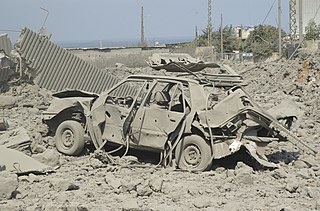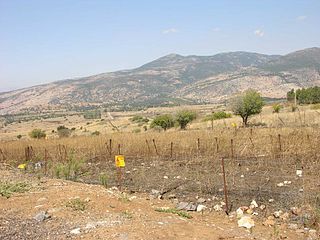
The United Nations Interim Force in Lebanon, or UNIFIL, is a UN peacekeeping mission established on 19 March 1978 by United Nations Security Council Resolutions 425 and 426, to confirm Israeli withdrawal from Lebanon which Israel had invaded five days prior, in order to ensure that the government of Lebanon would restore its effective authority in the area. The 1978 South Lebanon conflict came in the context of Palestinian insurgency in South Lebanon and the Lebanese Civil War.

The Blue Line is a demarcation line between Lebanon and Israel and Lebanon and the Golan Heights published by the United Nations on 7 June 2000 for the purposes of determining whether Israel had fully withdrawn from Lebanon. It has been described as: "temporary" and "not a border, but a “line of withdrawal”.

Operation Grapes of Wrath, known in Lebanon as the April Aggression, was a seventeen-day campaign of the Israeli Defense Forces against Hezbollah in 1996 which attempted to end rocket attacks on Northern Israel by the organisation. Israel conducted more than 1,100 air raids and extensive shelling. A UNIFIL compound at Qana was hit when Israeli artillery fired on Hezbollah forces operating nearby. 639 Hezbollah cross-border rocket attacks targeted northern Israel, particularly the town of Kiryat Shemona. Hezbollah forces also participated in numerous engagements with Israeli and South Lebanon Army forces. The conflict was de-escalated on 27 April by a ceasefire agreement banning attacks on civilians.
This is a timeline of events related to the 2006 Lebanon War.

The South Lebanon conflict, designated by Israel as the Security Zone in Lebanon Campaign, was a protracted armed conflict that took place in southern Lebanon from 1985 to 2000. It saw fighting between Israel and the Catholic Christian-dominated South Lebanon Army (SLA) against Hezbollah-led Shia Muslim and left-wing guerillas within the Israeli-occupied "Security Zone"; the SLA had military and logistical support from the Israel Defense Forces over the course of the conflict and operated under the jurisdiction of the Israeli-backed South Lebanon provisional administration, which succeeded the earlier Israeli-backed State of Free Lebanon. It can also refer to the continuation of the earlier conflict in this region involving the growing Palestinian insurgency in South Lebanon against Israel following the expulsion of the Palestine Liberation Organization (PLO) from Jordan after Black September. Historical tensions between Palestinian refugees and Lebanese factions contributed another layer to the Lebanese Civil War (1975–1990), which saw the Maronite-led Lebanese Front and the Shia Amal Movement at war with the PLO. Hence, the South Lebanon conflict can partly be seen as an extension of the civil war that ended in 1990.

During the 2006 July War, a number of international incidents occurred in Lebanon, largely involving United Nations personnel who have come under a number of attacks by Israeli forces.
There have been many casualties in the 2006 Lebanon War, leading to condemnation of both sides, however the exact distribution of casualties has been disputed. The Lebanese Higher Relief Council (HRC), UNICEF, and various press agencies and news organizations have stated that most of those killed were Lebanese civilians, however the Lebanese government does not differentiate between civilians and combatants in death toll figures. The Israeli government identified 43 Israeli civilians killed by Hezbollah rocket attacks, including four who died of heart attacks during rocket attacks. The Israel Defense Forces (IDF) death toll ranges from 118 to 121, depending on the source and whether or not casualties that occurred after the ceasefire are included. The figures for the Hezbollah fighters killed are the most varying, with Hezbollah claiming 250 of its fighters killed, while Israel claimed to have identified 530 dead Hezbollah fighters. The IDF estimates 600–700 dead Hezbollah fighters. Sources can be conflicting.
Marjayoun, also Marj 'Ayoun, Marjuyun or Marjeyoun which reflects the area's lush landscape and abundant water resources and Jdeideh / Jdeida / Jdeidet Marjeyoun, is a Lebanese town and an administrative district, the Marjeyoun District, in the Nabatieh Governorate in Southern Lebanon.
The 2006 Qaa airstrike was an attack by the Israel Air Force (IAF) on a building in the area of al-Qaa around 10 kilometers from Hermel in the Bekaa Valley, Lebanon on 4 August 2006. The attack took place during the 2006 Lebanon War. Thirty-three farm workers, mostly Syrian and Lebanese Kurds, were killed during the airstrike.

The 2006 Lebanon War, also called the 2006 Israel–Hezbollah War and known in Lebanon as the July War and in Israel as the Second Lebanon War, was a 34-day military conflict in Lebanon, northern Israel and the Golan Heights. The principal parties were Hezbollah paramilitary forces and the Israel Defense Forces (IDF). The conflict started on 12 July 2006, and continued until a United Nations-brokered ceasefire went into effect in the morning on 14 August 2006, though it formally ended on 8 September 2006 when Israel lifted its naval blockade of Lebanon. Due to unprecedented Iranian military support to Hezbollah before and during the war, some consider it the first round of the Iran–Israel proxy conflict, rather than a continuation of the Arab–Israeli conflict.
The Chyah Airstrike was an attack by the Israel Air Force (IAF) on the Shiyyah suburb in the Lebanese capital of Beirut on August 7, 2006, during the 2006 Lebanon War. Two missiles fired from an IDF bomber destroyed three apartment buildings in the suburb. Contemporary news accounts stated that the death toll from the airstrikes rose as recovery efforts continued, with 50 corpses recovered at the time of reportage and 61 anticipated.
The 2006 Ghaziyeh airstrikes also referred to as the 2006 Ghaziyeh massacre were two sequential attacks by the Israel Air Force (IAF) on the city of Ghaziyeh in Lebanon on August 7, and August 8, 2006. The attacks took place during the 2006 Lebanon War. In the first attack on August 7, the IAF bombed a building killing 16 people. In the second attack on August 8, the IAF fired five missiles into three buildings killing a total of 8 to 14 civilians and wounding 33. A total of 26 to 30 civilians died in the attacks.
United Nations Security Council Resolution 1701 is a resolution that was intended to resolve the 2006 Lebanon War.
The Operation Change of Direction 11 was the final offensive operation by the Israel Defense Forces (IDF) during the 2006 Lebanon War that began on August 11, 2006, and ended three days later when the ceasefire came into effect. It involved a tripling of Israeli forces inside Lebanon and aimed at encircling Hizbullah forces in south Lebanon. The plan was to advance westwards along the Litani River from the Galilee Panhandle, combined with helicopter landings behind enemy lines, intended to be the largest in IDF history, and simultaneous advances northwards in the central sector and along the Mediterranean coast. The plan was to follow up the offensive by several weeks of mopping-up operations in the surrounded territories, eliminating Hizbullah infrastructure, especially in the launching areas of Katyusha rockets.

A number of incidents of attack on civilian and UN convoys have been reported. The Israel Defense Forces has disputed involvement in some cases, and has also alleged that no prior coordination took place before some affected convoys set out. These allegations have in turn been disputed. There have also been reports that fear of aerial attack has prevented drivers from transporting humanitarian aid within Lebanon. One estimate two weeks into the conflict placed the number of Lebanese truck drivers who had died as a result of IDF/IAF air strikes on convoys as "dozens".

The 2000–2006 Shebaa Farms conflict was a low-level border conflict between Israel and Hezbollah for control of Shebaa Farms, a disputed territory located on the Golan Heights–Lebanon border. Fighting between the two sides primarily consisted of Hezbollah rocket and mortar attacks on Israel and Israeli artillery barrages and airstrikes on Hezbollah in southern Lebanon. Clashes began a few months after the 2000 Israeli withdrawal from Lebanon, which Hezbollah viewed as incomplete due to the presence of the Israel Defense Forces in Shebaa Farms. The conflict culminated in the 2006 Lebanon War; Israel retains control over the territory.
Allegations of war crimes in the 2006 Lebanon War have been made by various groups and individuals, including Amnesty International, Human Rights Watch, and United Nations officials, who accused both Hezbollah and Israel of violating international humanitarian law. These have included allegations of intentional attacks on civilian populations or infrastructure, disproportionate or indiscriminate attacks, the use of human shields, and the use of prohibited weapons.
The 2010 Israel–Lebanon border clash occurred on August 3, 2010, between the Lebanese Armed Forces (LAF) and Israel Defense Forces (IDF), after an IDF team attempted to cut down a tree on the Israeli side of the Blue Line, near the Israeli kibbutz of Misgav Am and the Lebanese village of Odaisseh. A high-ranking IDF officer was killed and another wounded, when LAF snipers opened fire on an Israeli observation post after receiving authorization from senior Lebanese commanders. IDF soldiers returned fire and responded with artillery shelling and airstrikes on Lebanese positions, killing two Lebanese soldiers and Al Akhbar correspondent Assaf Abu Rahhal, as well as wounding five soldiers and one journalist. This was the most serious escalation on the border since the 2006 Lebanon War.

The Israeli occupation of Southern Lebanon formally began in 1985 and ended in 2000 as part of the South Lebanon conflict. In 1982, Israel invaded Lebanon in response to a spate of attacks carried out from Lebanese territory by Palestinian militants, triggering the 1982 Lebanon War. The Israel Defense Forces (IDF) and allied Christian Lebanese militias subsequently seized large parts of Lebanon, including the capital city of Beirut, amid the hostilities of the wider Lebanese Civil War. Israel later withdrew from most of the occupied territory between 1983 and 1985, but retained control over areas along the Israel–Lebanon border that would later comprise the Israeli "Security Zone" in coordination with the separatist State of Free Lebanon, which collapsed in 1984. From 1985 onwards, Israel supported the South Lebanon Army (SLA), the Lebanese Christian quasi-military of the collapsed Free Lebanon State, against Hezbollah and other Muslim militants in most of Southern Lebanon; Israel's overall stated purpose for the Security Zone was to create a buffer separating Israeli civilians in northern border towns from Lebanon-based terrorists. In 1993, it was estimated that there were 1,000–2,000 Israeli troops and 2,300 SLA troops active in the area.








